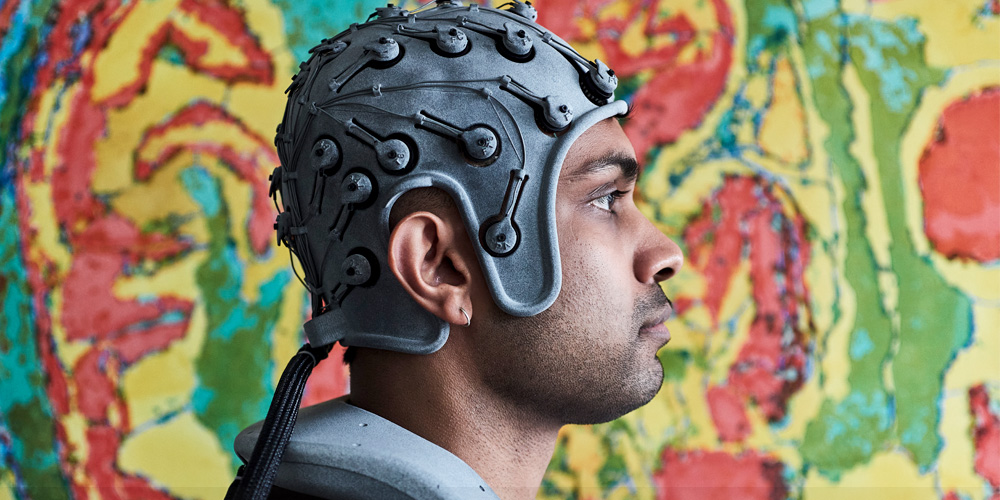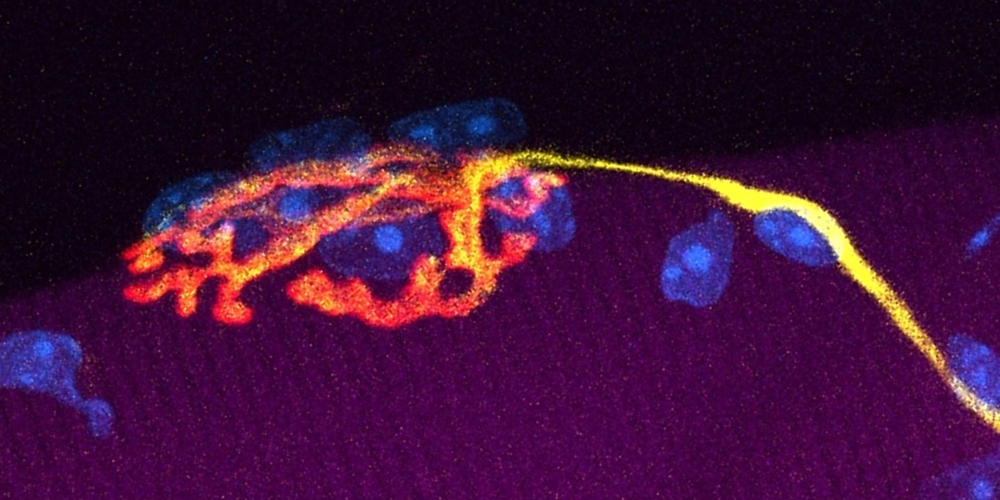Innovative treatment helmet promises advances in the treatment of Alzheimer’s
The Basel spin-off company Bottneuro is developing a personalized treatment helmet – the Miamind neurostimulator. Thanks to targeted brain electrostimulation, the innovative device is intended to have a positive effect on the course of diseases such as Alzheimer’s, as there is a huge market for treating patients with degenerative brain disease.
02 April 2024 | Christian Heuss
Electrical stimulation of certain areas of the brain can be used to treat degenerative diseases such as Alzheimer’s or Parkinson’s. Dr. Bekim Osmani, co-founder and CEO of Bottneuro, a spin-off of the Department of Biomedical Engineering at the University of Basel, states that this has been demonstrated in scientific studies over the last few years.
However, stimulating areas of the brain through the top of the skull in a targeted manner is a difficult undertaking and no standard treatment is available due to the various head shapes and brain sizes people have. Bottneuro now offers a personalized solution – the Miamind neurostimulator. The system developed in Basel consists of a tailor-made helmet equipped with 34 electrodes. The precise shape of the helmet and the electrode placement is determined for each individual patient based on an MRI scan of their head and brain and modeled on a computer. A 3D printer produces the finished helmet, which sits perfectly on the patient’s head.
“We are developing the first medical device that provides personalized electrostimulation treatment in a mobile device,” states Bekim Osmani. The helmet also includes a shoulder belt, containing electronics for controlling the electrodes, and a tablet, enabling the patient to start the treatment. Miamind generates electric fields that stimulate the specific regions of the brain by means of the 34 electrodes, and the device can then also use the same electrodes to create an electroencephalogram (EEG) and measure changes in brain currents.
Treatment at home
“Previously, patients had to go into a clinical setting to be treated with similar systems,” states Osmani. “The treatment could only be carried out with external assistance and complex research equipment.” Independent at-home use is now possible; the measurement data is then automatically transmitted to the attending neurologist in the clinical setting.
The device hasn’t just made advances in terms of its mobile usability – individual placement of the electrodes depending on the patient’s brain size and shape is also of therapeutic interest. “We can therefore determine extremely precisely which areas are electrically stimulated,” states neurobiologist Dr. Alois Hopf, Chief Scientific Officer of Bottneuro. Based on the treatment goal of the attending physicians, the stimulation treatment can be coordinated to the affected areas of the brain. The tailor-made helmet also ensures that precisely the same areas of the head are stimulated during each treatment session.
Initial clinical studies
Together with electronic partners in Switzerland, Bottneuro developed hardware and software for this device. To date, investors and foundations have financed the development of the spin-off company with CHF 7 million. Bottneuro has entered a new phase of development thanks to the recent registration as a medical device by Swissmedic and the effectiveness of the electrostimulation is now being investigated as part of clinical tests. The company is testing the safety and reliability of Miamind as part of a first phase with an initial eight subjects. Does electrostimulation have an impact on the subjects’ alertness? How does device operation work in practice? The company is studying these types of questions in collaboration with Prof. Raphael Guzmann, Director of Neurosurgery at the University Hospital Basel and co-founder of Bottneuro.
“Mobile stimulation devices have potential when it comes to treating patients with neurological diseases,” he states. For example, initial studies indicate that they have an effect when it comes to neurodegenerative diseases such as Alzheimer’s and the technology could offer functional improvements for patients with epilepsy or who have had a stroke. Guzman also stresses that there is still a long way to go to demonstrate the efficacy of Miamind. “Randomized clinical studies on affected patients are required for this.”
These kinds of studies are extremely time-consuming and expensive, as the costs for these studies are in the ballpark of CHF 20 to 50 million. By registering the product in Germany and the US, the company also hopes to gain access to foreign investors.
Interest from private clinics
Bekim Osmani is now also looking for customers who want to use the device on their patients. “We are receiving a lot of interest from exclusive private clinics in Switzerland and England that offer innovative therapeutic applications to their patients.” The device currently costs around CHF 50,000 per year as a rental model or can also be purchased for CHF 190,000.
“You have to consider the currently high cost of the device in relation to the ‘Lecanemab’ Alzheimer’s medication recently approved in the US,” states Osmani. It costs approx. CHF 80,000 per year overall there. If larger quantities are produced, the price of Miamind will also be reduced by a factor of five.
In addition to Alzheimer’s, it could also be used in the event of a stroke, in the case of severe depression, epilepsy or Parkinson’s. However, evidence on whether the innovative device from Basel is beneficial for any of the severe conditions must first be provided.





